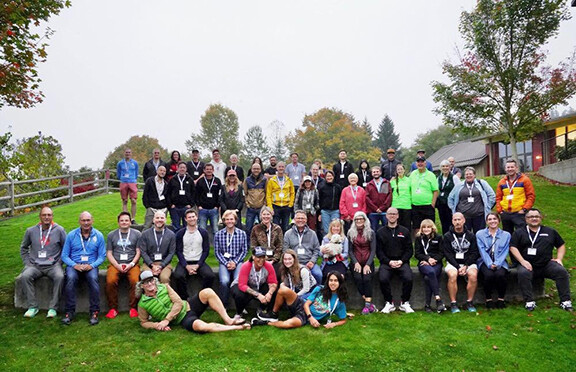Finding good employees. Hiring those employees. Keeping those employees.
Those are the three biggest challenges retailers face in running their businesses in 2019. Nothing new there, but the way to solve these challenges has certainly changed with the times — and the employees.
Among the many run specialty retailers who attended The Running Event 2018 in Austin, TX, many identified labor as the single biggest challenge confronting their operation.
Jeff Anderson of Kelley’s Pace in Mystic, CT, reported losing four staff members in August alone. He was considering more full-time employment to boost staff retention and eager to show specialty retail as a viable career, not simply a temporary side hustle.
Outside of Boston, Whirlaway Sports Center was actively seeking to bolster staff engagement through special events. From guiding the store’s Captains’ Night to preparing for the annual Whirlaway Tent Sale, general manager Maggi Murray says special events allow Whirlaway staff to experience different environments and tackle new responsibilities, giving them an important jolt of energy and a greater sense of involvement.
Here today, more than a half-year later, labor remains a pressing concern.
“At Kelley’s Pace, we seem to be always looking for someone … [and] I am always looking for that perfect fit,” Anderson says. “I find myself investing more in training, figuring out which deficiencies I can change via training [and] what attributes make up for other deficiencies.”
In a high-touch, customer-centric environment like run specialty, one that earns its keep by insisting on involved, genuine interactions with customers, personable, capable staff are critical drivers of store performance. According to a recent consumer survey from the International Council of Shopping Centers, two-thirds of consumers say good customer service encourages them to stay longer and/or spend more money at a store.
Yet running stores across the country continually struggle to find and retain capable staff, a concerning problem as run shops push to be more engaging and experiential spaces. This struggle, many say, poses a threat to their business and has fueled an intensifying appetite for solutions.
Finding Solutions, Wherever
Truth be told, running retailers aren’t the only ones facing labor woes. From restaurants to the trades to white-collar jobs in fields like insurance or finance, employers across the American landscape are longing for skilled workers at a time when national unemployment sits at a 49-year low. That reality has ignited a range of creative and aggressive initiatives designed to recruit and retain talent while also compelling business leaders to more critically assess what attracts and keeps high-quality people on board.
Running Insight investigated how businesses, including those beyond the retail world, are hiring and retaining staff as well as noteworthy data on battling the labor conundrum.
Creative Recruiting Strategies
While businesses aren’t necessarily throwing out the traditional recruiting playbook, they are most certainly embracing novel ways to talk about their companies to prospective employees.
Last year, for instance, Taco Bell trialed “hiring parties” in Indianapolis, pairing free food and swag with on-the-spot job interviews. Over two days at four different restaurants, Taco Bell ended up with 40 new hires. The success of those events prompted Taco Bell to host nearly 600 parties across the country this past April.
Others are mining oft-overlooked candidates, including retirees. Major restaurant chains like Bakers Square and Village Inn, for instance, have paid job listings on the AARP website, while McDonald’s has targeted seniors as well.
While running shops have long turned to their customer base, running clubs and local college programs for prospective employees, it’s increasingly evident that store leaders will have to investigate alternative methods to attract candidates and stand out with employees, especially as the labor shortage shows no signs of slowing.Highlight Mission and Culture
Running stores do something immensely valuable: They help people lead healthier, more active lives. That’s a noble purpose many can get behind and something retailers would be wise to note regularly, both when interviewing prospects as well as in communications with current staff members.
Deliver a formal training program, but ditch the formalities
According to the Sitel Group’s recent “Future of Work and Employee Learning” report, 79 percent of employees seeking a job say it’s important that an employer has a formal training program, though 83 percent consider “on-the-job” training, especially that with a designated mentor, more effective than classroom or e-learning.
As employees clearly prize formal training, share information about the store’s training programs during an interview, particularly highlighting what employees learn and ways they continue to develop their skills.
Competitive Compensation
As specialty retailers demand more of their staff in the experiential economy, it’s important that compensation keep pace. Among full-time staff, that means a competitive salary paired with solid benefits that promote a career, not simply a job.
The average retail wage reached $19.47 per hour in April. As hourly wages rise, not only at the behest of governments but also propelled by companies such as Amazon and Walmart, the heat is on independent retailers to be a competitive bunch.
In western New York, Fleet Feet operators Ellen Brenner-Boutillier and Boots Boutillier have Project 20/21, a commitment to raise their company’s minimum wage to $20 per hour by the end of 2021.
“We believe our customer service is an art and not everybody can do it,” Brenner-Boutillier told Running Insight upon launching the effort two years ago. “We want to make sure our staff is known, validated and respected.”
Additional perks such as favorable product discounts, complimentary race entries, paid time off, a 401k or an incentive program that rewards employees for hitting milestones can also prove advantageous.
Tackling the Millennial Anchor
Millennials and Gen Z have been saddled with student debt – about $30,000 by various estimates – and InsideOut’s 2019 study found only 30 percent are confident they’ll be able to repay their student loans despite it being their top financial priority. Acknowledging this, a growing number of large companies – albeit only four percent, says the Society for Human Resources Management – are helping workers pay down their student loans with cash payments up to $250 per month. In an alternative to direct payments, insurance company Unum Group allows workers to trade paid vacation days for money toward their student loan.
Meanwhile, companies like Starbucks, McDonald’s and Chipotle all tout some form of tuition assistance for employees currently enrolled in school — about 10 percent of the U.S. workforce.
It would be an undeniably ambitious endeavor for any running store to unveil a program that attacks student debt, but also the type of initiative that could help a business stand out with prospects and encourage high-quality staff to stay.
More Than a Gig
Some opine that employee loyalty is dead in the gig economy, where folks can easily skip to an Uber-like side hustle that offers work on their time. But the predictability and stability a steady job provides remains valuable — for both employers and their teams.
Providing employees regular hours and consistent work schedules has been shown to boost employee loyalty and spark increases in sales and productivity, according to recent research published in the Harvard Business Review about a pilot program at The Gap.
Help People Grow
The Sitel Group’s report uncovered that 37 percent of employees said they would leave their current job if they were not offered training to learn new skills. In addition, 92 percent said learning something new on the job increased motivation and engagement with their work. Helping staff develop, then, contributes to both productivity and retention.
Work with staff to identify the skills they want to develop – sales or leadership, for instance – or areas they want to learn more about, such as purchasing inventory or race management, and create a plan to improve their knowledge in those areas.
Provide Opportunities to Shine
Sue Bingham, founder of organizational development firm HPWP Group, says organizations often structure jobs that use only 30-60 percent of their employees’ brainpower, which threatens productivity and employee engagement. Bingham adds that employees encouraged to work beyond their assigned roles frequently show greater drive and dedication.
A Randstad US survey examining the top reasons people quit their jobs puts Bingham’s comments in quantitative terms: 69 percent of employees said they would be more satisfied if their employers better utilized their skills and abilities.
Look to leverage staff talents and interests. From photography and graphic design to those interested in race timing, store events or training, find ways to bring staff talents out into the open.
Show Advancement Chances
With new skills in hand, employees often desire a step up in the workplace. Absent advancement opportunities, they’re more likely to leave. The Randstad US survey, in fact, found that 58 percent of workers left because their company didn’t have enough long-term growth opportunities.
Savvy business owners, especially small business owners, combat this by promoting from within as much as possible and rolling out new responsibilities and even job titles to qualified staff members.
Show staff a path beyond the sales floor by taking them to The Running Event, bringing them into footwear meetings and entrusting them with new tasks that fit their abilities, whether that’s related to merchandising, marketing or events.
Install a Capable Manager
The biggest reason a business might struggle to retain talent might be the people leading the business. According to a 2019 study of Gen Z employees from InsideOut Development, one in four respondents said they would leave an organization because of a boss who manages through fear.
Gallup CEO Jim Clifton once went as far as saying that naming a manager is the single biggest decision a business owner makes. Clifton said nothing – not compensation nor shiny perks – could fix a poor manager.
In contrast, having a respected manager in place could be just the ticket to improving retention.
Value Employees
The Randstad US survey found that 59 percent of people quit their jobs when companies view their own financial performance as more important than how people are treated. It’s a reminder that employees need to feel valued and respected, lest labor’s revolving door will continue spinning.
Whether its spending time on the floor and tackling tasks alongside staff, sincerely recognizing a job well done or soliciting feedback on potential workplace improvements, showing employees that they are valued, important and worthy is vital to keeping them engaged and loyal.







